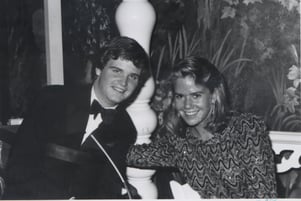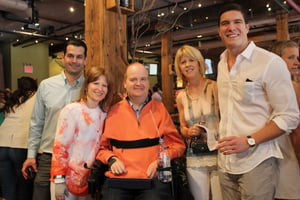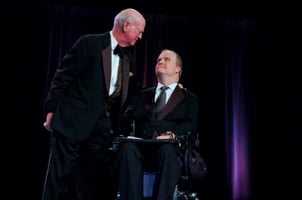Hope Happens Here: The Stifel Family - Reeve Foundation
On a late winter day in 1982, Henry Stifel was in a car accident that shattered his vertebrae, leaving him paralyzed from the chest down.
Henry was 17-years old; he had an entire life left to live. But when his parents, Hank and Charlotte Stifel, pressed doctors about what came next, the answers they got were grim, a reflection of the widespread belief at the time that spinal cord injuries were untreatable. Christopher Reeve was already Superman, but the Reeve Foundation wouldn’t exist for another 17 years. There was no Googling resources on the internet, no support groups ready to offer tips for treatment and care, no organization with its gaze trained on a cure. And so, the Stifels decided to build their own.
The Stifel Paralysis Research Foundation launched later that year while Henry was learning how to manage his new injury at a nearby rehabilitative hospital. Hank Stifel, an Air Force veteran and successful New Jersey businessman, harnessed the family’s resources, tapping a network of friends who were eager to help Henry by strengthening the sparse field of spinal cord research.
Susan Howley, one of the foundation’s original employees, describes the first makeshift office as a bridge table in Henry’s bedroom. It was a determined, but distinctly family-centric effort; after the foundation found space in a nearby office, Howley would stop by the Stifel home each morning to pick up the tasks Hank would leave for her in the milk box and then return the finished work at day’s end.
Beneath each new endeavor, from writing newsletters for a growing community of supporters to seeking out scientists whose research might lead to a cure, was a clear sense that this was not only about the Stifels, but thousands of other families affected by spinal cord injuries.
“There really wasn’t a lot of hope for patients at the time,” Howley said. “They were told, ‘This is your life, get used to it.’ But Hank and Charlotte just didn’t accept that.”
Instead, the Stifels immersed themselves in tracking the science and research of the day. When they couldn’t find spinal cord centric researchers, they got as close as they could, awarding the foundation’s first grants to scientists studying the brain and central nervous system. And they didn’t limit their search to just the U.S: When Martin Schwab, a neuroscientist and professor at the University of Zurich, had a breakthrough in regeneration and functional repair related to spinal cord injuries, the Stifels flew across the ocean to visit his lab and would later fund his future work.
In the mid-1980s, Hank brought the foundation under the umbrella of the American Paralysis Association (APA), where he helped establish an external scientific advisory council led by Carl Cotman, a neuroscientist from the University of California, to review and advise its grant awards. The added scientific rigor helped expand the number of scientists and academics pursuing spinal cord research and encourage the innovative work that would eventually upend the notion that there was nothing to be done for patients.
This is how a movement began, with persistence and grit and unshakeable hope in a better future. One family could—and did–make a difference.
When Christopher Reeve was injured in 1995, his family had a place to seek help and support. By then, Henry was a successful banker living in New York City, an inherent rebuke to the notion that life ended after spinal cord injury. After the APA and the Christopher Reeve Foundation merged, Henry joined the board as vice chair, a position he retains to this day. Over the next two decades, his family continued its dedicated efforts to expand what is possible for those living with spinal cord injuries; his parents would become familiar faces at every gala, while Henry’s sisters, Stephanie, Wendy and Amy, would run marathons, host fundraisers and support the foundation staff in countless ways.
Building on the work begun by the Stifels, the Reeve Foundation has invested more than $120 million in research around the world, including the groundbreaking epidural stimulation program at the University of Louisville.
Just before his father died, Henry saw Rob Summers, the first recipient of an implantable epidural stimulator, stand up on his own. Henry recorded the moment on his phone and later replayed it for Hank, who watched it from his hospice bed, 31 years after doctors had said there was nothing to be done for people wth spinal cord injuries.
“I was able to say to my father, ‘You did it, Dad,” Henry said. “We all did it.”
The breakthrough moment was a glimpse of a future that might never have arrived if Hank and Charlotte Stifel hadn’t stubbornly refused to believe nothing could be done when their only son was paralyzed.
“It was such a creative and constructive way to take the horror of this injury and turn it into something positive,” Susan Howley said. “It sounds Pollyannaish but it’s true. Look at what’s come out of what they started. It’s a hell of a legacy."
Join Our Movement
What started as an idea has become a national movement. With your support, we can influence policy and inspire lasting change.
Become an Advocate